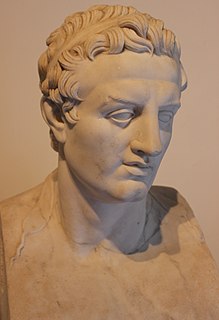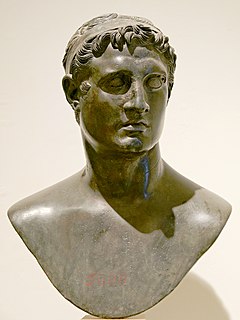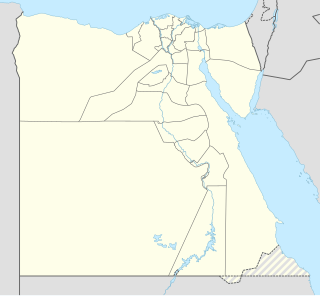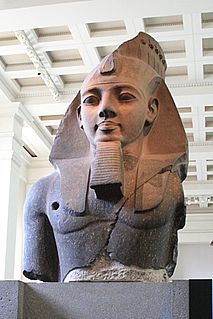External links
- The Great Mendes Stela : English translation
| This article about Egyptology or subjects relating to Ancient Egypt is a stub. You can help Wikipedia by expanding it. |
The Great Mendes Stela is a commemorative stele erected during the Ptolemaic dynasty by Ptolemy II Philadelphus for Mendes, Lower Egypt. Ptolemies III through V also had stelae: the bilingual, three-script Decree of Canopus and the Rosetta Stone.
| This article about Egyptology or subjects relating to Ancient Egypt is a stub. You can help Wikipedia by expanding it. |

Osiris is the god of fertility, agriculture, the afterlife, the dead, resurrection, life, and vegetation in ancient Egyptian religion. He was classically depicted as a green-skinned deity with a pharaoh's beard, partially mummy-wrapped at the legs, wearing a distinctive atef crown, and holding a symbolic crook and flail. He was one of the first to be associated with the mummy wrap. When his brother, Set, cut him up into pieces after killing him, Isis, his wife, found all the pieces and wrapped his body up. Osiris was at times considered the eldest son of the god Geb and the sky goddess Nut, as well as being brother and husband of Isis, with Horus being considered his posthumously begotten son. He was also associated with the epithet Khenti-Amentiu, meaning "Foremost of the Westerners", a reference to his kingship in the land of the dead. Through syncretism with Iah, he is also a god of the Moon.

Arsinoë II was a Ptolemaic queen and co-regent of the Ptolemaic Kingdom of ancient Egypt.

Ptolemy III Euergetes was the third king of the Ptolemaic dynasty in Egypt from 246 to 222 BC. The Ptolemaic Kingdom reached the height of its power during his reign.

Ptolemy I Soter was a companion and historian of Alexander the Great of the Kingdom of Macedon in northern Greece who became ruler of Egypt, part of Alexander's former empire. Ptolemy was pharaoh of Ptolemaic Egypt from 305/304 BC to his death. He was the founder of the Ptolemaic dynasty which ruled Egypt until the death of Cleopatra in 30 BC, turning the country into a Hellenistic kingdom and Alexandria into a centre of Greek culture.

Ptolemy II Philadelphus was the pharaoh of Ptolemaic Egypt from 283 to 246 BCE. He was the son of Ptolemy I Soter, the Macedonian Greek general of Alexander the Great who founded the Ptolemaic Kingdom after the death of Alexander, and queen Berenice I, originally from Macedon in northern Greece.

In Egyptian mythology, Ptah is the demiurge of Memphis, god of craftsmen and architects. In the triad of Memphis, he is the husband of Sekhmet and the father of Nefertum. He was also regarded as the father of the sage Imhotep.

Mendes, the Greek name of the Ancient Egyptian city of Djedet, also known in Ancient Egypt as Per-Banebdjedet and Anpet, is known today as Tell El-Ruba.

A stele, or occasionally stela, when derived from Latin, is a stone or wooden slab, generally taller than it is wide, erected in the ancient world as a monument. The surface of the stele often has text, ornamentation, or both. These may be inscribed, carved in relief, or painted.

The Famine Stela is an inscription written in Egyptian hieroglyphs located on Sehel Island in the Nile near Aswan in Egypt, which tells of a seven-year period of drought and famine during the reign of pharaoh Djoser of the Third Dynasty. It is thought that the stele was inscribed during the Ptolemaic Kingdom, which ruled from 332 to 31 BC.

Shepsesre Tefnakht was a prince of Sais and founder of the relatively short Twenty-fourth dynasty of Egypt; he rose to become a Chief of the Ma in his home city. He is thought to have reigned roughly 732 BCE to 725 BCE, or 7 years. Tefnakht I first began his career as the "Great Chief of the West" and Prince of Sais and was a late contemporary of the last ruler of the 22nd dynasty: Shoshenq V. Tefnakht I was actually the second ruler of Sais; he was preceded by Osorkon C, who is attested by several documents mentioning him as this city's Chief of the Ma and Army Leader, according to Kenneth Kitchen, while his predecessor as Great Chief of the West was a man named Ankhhor. A recently discovered statue, dedicated by Tefnakht I to Amun-Re, reveals important details about his personal origins. The statue's text states that Tefnakht was the son of a certain Gemnefsutkapu and the grandson of Basa, a priest of Amun near Sais. Consequently, Tefnakht was not actually descended from either lines of Chiefs of the Ma and of the Libu as traditionally believed but rather came from a family of priests, and his ancestors being more likely Egyptians rather than Libyans.
The Raphia Decree is an ancient inscribed stone stela dating from ancient Egypt. It comprises the second of the Ptolemaic Decrees issued by a synod of Egyptian priests meeting at Memphis under Ptolemy IV of the Hellenistic Ptolemaic dynasty, which ruled Egypt from 305 BC to 30 BC. The slab dates itself to 217 BC, and celebrates Ptolemy IV's victory at the Battle of Raphia.
The Decree of Canopus is a trilingual inscription in three scripts, which dates from the Ptolemaic period of Ancient Egypt. It was written in three writing systems: Egyptian hieroglyphs, demotic, and Greek, on several ancient Egyptian memorial stones, or steles. The inscription is a record of a great assembly of priests held at Canopus, Egypt, in 238 BCE. Their decree honoured Pharaoh Ptolemy III Euergetes; Queen Berenice, his wife; and Princess Berenice.

Khabash, also Khababash or Khabbash, resided at Sais in the fifth nome of Lower Egypt in the fourth century BCE. During the second Persian occupation of Egypt he led a revolt against the Persian rule in concert with his eldest son, from ca. 338 to 335 BCE, a few years before the conquest of Egypt by Alexander the Great. It is said that Nectanebo II, the exiled last native ruler of Egypt, may have helped in these events, but he was possibly sidelined for good as a result of the failure of the revolt.

The Ptolemaic Kingdom was a Hellenistic kingdom based in ancient Egypt. It was ruled by the Ptolemaic dynasty, which started with Ptolemy I Soter's accession after the death of Alexander the Great in 323 BC and which ended with the death of Cleopatra and the Roman conquest in 30 BC.

Banebdjedet (Banebdjed) was an Ancient Egyptian ram god with a cult centre at Mendes. Khnum was the equivalent god in Upper Egypt.

The Department of Ancient Egypt and Sudan is a department forming an historic part of the British Museum, housing the world's largest and most comprehensive collection of Egyptian antiquities outside the Egyptian Museum in Cairo.

Iuput II was a ruler of Leontopolis, in the Nile Delta region of Lower Egypt, who reigned during the 8th century BC, in the late Third Intermediate Period.
The Nubayrah Stele is a mutilated copy of the Decree of Memphis on a limestone stele. The same decree is found upon the Rosetta Stone. From 1848, it was known that a partial copy of the Decree was on a wall at the Temple of Philae, but overwritten in many places, by scenes, or damaged.
Articles related to ancient Egypt include:
Ptolemy Epigonos was a Greek Prince from Asia Minor who was of Macedonian and Thessalian descent.